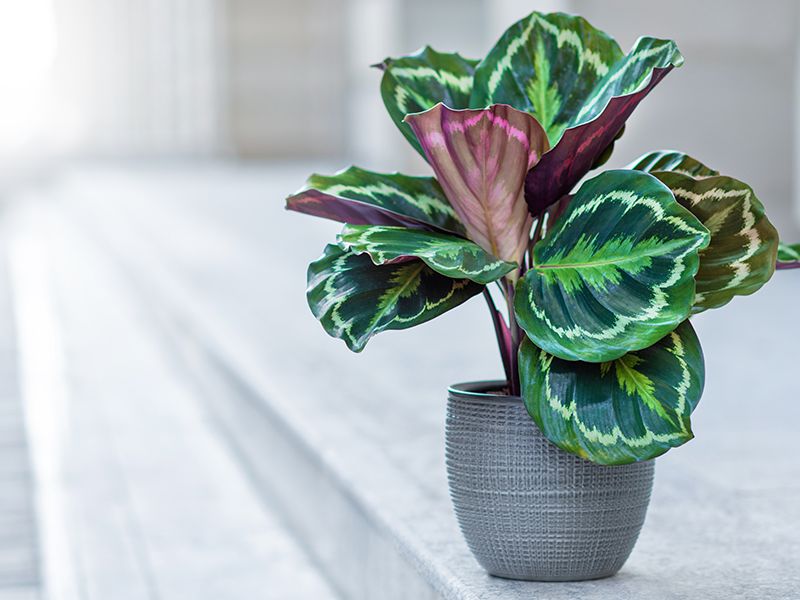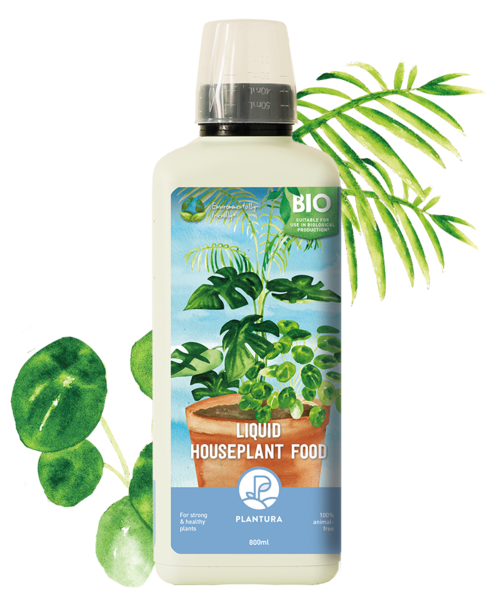Known by their botanical name Calathea, prayer plants originate from the tropical regions of Central and South America. With proper care, these tropical plants will add an exotic and elegant touch to any space. Have a read to find out everything you need to know about growing them!
The prayer plant has captivating leaves which are lusciously green and rich in contrast [Photo: Firn/ Shutterstock.com]
The prayer plant’s lush, green leaves are covered in dramatic patterns. It is a richly aesthetic plant that is a fantastic addition to any space. However, when introducing calathea to your home, there are a few things to bear in mind.
Contents
Calathea: origin and characteristics
The prayer plant (Calathea) originates from the swampy forests of the Central and South-American tropics and belongs to the Marantaceae family of flowering tropical evergreens. In the tropics, calathea blossoms with spiked, orange flowers throughout January and February. Outside the tropics, however, they rarely flower. But have no fear! With a little care, calathea can make a fantastic houseplant wherever you live.
While the plant is young, its leaves are especially vibrant. They are luscious green and covered in intense patterns. These patterns tend to be white, but fade with age, as the leaves take on a more uniform green. But there is variation. Some leaves have purple undersides that don’t fade, some are elongated and pointy, while others still are egg-shaped and rounded.
Curiously, during the day, a prayer plant’s leaves will lay flat and open. At night, however, they tend to curl up, as if in prayer, hence the plant’s nickname. By folding and unfolding its leaves, the prayer plant regulates its photosynthesis. What is more, prayer plants are not one-size-fits-all: Calathea orbifolia, for example, can grow up to 1m tall, while the Calathea lancifolia ‘Insigne’ is normally only 60cm tall!
The undersides of the leaves of some prayer plant species are purple [Photo: TOXIC CAT/ Shutterstock.com]How to plant calathea
Calathea is very sensitive to its environment. As a rule of thumb, the prayer plant will perform best in its natural habitat: the tropics, so it is best to mimic these conditions as best you can.
The optimal location for calathea
Prayer plants naturally grow on shady, rain forest floors. As such, a semi-shaded or brightly lit area is perfect. Avoid direct sunlight, as too much can cause its leaves to dry up and “burn”. What is more, the prayer plant requires humidity. If it is sitting in a room that is too dry, brown necroses can occur, where bits of dead plant tissue form on the edges or tips of its leaves.
Above all else, prayer plants are tropical. They enjoy temperatures between 20 and 24°C during summer, and 18°C in winter, when they are dormant. Do not subject your prayer plant to any cold drafts, and be sure to keep it above 15°C.
What kind of soil is suitable for calathea?
High-quality, loose potting soil made specifically for houseplants is perfect for calathea. Our Plantura Organic All Purpose Compost, for example, has an ideal pH value and is nutrient-rich, which encourages healthy plant development.
But remember: the soil must be loose as prayer plants are sensitive to waterlogging. To ensure the soil is loose and drains well, you can use a substrate mix consisting of about 30 % expanded clay and 70 % potting soil. You can also add a layer of expanded clay to the bottom of your pot to allow any excess water to runoff.
Tip: As a jungle plant, calathea thrives in acidic soil. To make your soil more acidic, add to it small quantities of needle litter, rock meal, or bark mulch.
How to plant calathea: a step-by-step guide
Because the prayer plant grows flat and broad roots, it will appreciate a flat and broad pot. What is more, by having such a large surface area, the pot will allow water to evaporate more quickly, which in turn humidifies the plant. And be sure that your pot has large holes at the bottom so that water can drain out.
Once you have the right pot, place your prayer plant in it, cover the plant with soil, pat it down and water. When repotting, avoid adding too much soil – no more than the calathea had in its old pot. Too much soil can lead to waterlogging.
Calathea leaves are able to stand upright or roll up at night [Photo: mokjc/ Shutterstock.com]How to care for calathea
Prayer plants can be demanding, but with proper care they will thrive. For instance, it is a good idea to wipe their leaves with a damp cloth to remove dust and promote photosynthesis. But do so with care: damaged leaves will not grow back.
Calathea watering
For the prayer plant, watering is vital. If it is dehydrated long enough, calathea’s leaves will become limp and curl up during the day. From April to October, water your plant once or twice a week with rainwater or mineral water. Tap water can contain high levels of lime, which changes the pH of the soil. During winter dormancy – November to March – water it less.
In addition to watering its roots, which should be done with care so as to avoid root rot, regularly spray your prayer plant’s leaves. This will help recreate a tropical climate and prevent its leaf tips from drying out.
How to fertilise calathea
The prayer plant doesn’t need a lot of fertilisation, and certainly not during winter. However, adding liquid fertiliser to the soil every three to four weeks between April and October is a good idea. Ideally, fertilise the plant while you water it. The nutrients will reach the root system much more quickly and evenly. Our Plantura Liquid Houseplant Food has added microorganisms to support root growth: a perfect choice!
Liquid Houseplant Food, 800ml
- Perfect for a wide variety of houseplants & foliage plants
- Liquid fertiliser for robust plants & healthy growth
- Quick & easy application – child & pet friendly
Shop now!
How to prune a prayer plant
Calathea plants do not need to be pruned but do remove dry and damaged leaves. And as you do so, be sure to check for any infestations.
Overview: common mistakes when caring for prayer plants
- Overwatering: withered leaves; can lead to root rot and fungal infection.
- Dehydration: leaves curl up (note: prayer plant leaves stand upright or curl up at night time – this is normal and should not be confused with water shortage).
- Not enough light: leaf patterns fade, and the plant doesn’t grow.
- Too much light: the plant is located in direct sunlight and the leaves display brown damage (“burns”).
- Too cold: the plant hardly grows; new leaves don’t form, and the leaves turn yellow.
- Humidity is too low: the plant’s leaf tips and edges are coloured brown.
 The leaves of various prayer plant species differ in shape, colour, patterning and size [Photo: Dewin ID/ Shutterstock.com]Repotting calathea
The leaves of various prayer plant species differ in shape, colour, patterning and size [Photo: Dewin ID/ Shutterstock.com]Repotting calathea
Your prayer plant should not be repotted for two years, and only when its pot is too small. But be careful: if the new pot is too large, there will be areas of soil that the roots do not reach. These areas will become too wet and root rot may occur.
The best time to repot calathea is in spring, before its growing period begins. Once the plant has been taken out of its old pot and the old soil has been carefully brushed off, examine its roots. If any areas of the root system are brown or rotten, cut them off to prevent the damage spreading.
Overwintering the calathea plant
With proper care, calathea has no trouble with winter. Brightly lit rooms that are maintained at around 18°C are perfect. A study, guest room, or brightly lit staircase will work just fine. Just be sure that the room does not dip below 15°C or experience any major temperature changes.
During winter dormancy, you should not need to fertilise your prayer plant, but do regularly check the soil with your finger. If the soil is dry, lightly water it, so that the plant’s roots do not dry out. In April, as the prayer plant enters its growing phase, you can move it back to its summer location and begin fertilising it.
How to propagate a prayer plant
To propagate your calathea you will have to cut offshoots from the mother plant. The best time to do this is spring when the plants are being repotted. Remove the mother plant from its pot and brush away the old soil. Split the bulbous roots in such a way that the new plant has two to seven leaves; it needs enough roots. Fill two plant pots with a good soil mix, plant the calathea and press firmly. Our Plantura Organic All Purpose Compost is ideal for the young plant After repotting, water the plants generously and place them in a bright, warm room.
 With a bit of care the prayer plant can be split in order to allow propagation [Photo: S1001/ Shutterstock.com]
With a bit of care the prayer plant can be split in order to allow propagation [Photo: S1001/ Shutterstock.com]
Prayer plant seeds can also be cultivated, though this is tricky and requires a particular kind of soil. Our Plantura Organic Herb & Seeding Compost works well. Simply cover the calathea seeds with about 2mm of the potting soil, water generously and place the pot in a miniature greenhouse or zip-lock bag on the window sill to mimic the humidity of tropical climates. It is a good idea to occasionally air your greenhouse to prevent mould.
Is the prayer plant poisonous?
Prayer plants are not poisonous. In fact, their leaves are used in areas of Brazil and Columbia as food containers. The stems are also used to weave baskets, which is why the prayer plant is also known as the “basket plant” in some countries. However, pets may experience adverse side effects if they eat the plant’s leaves, such as vomiting. Otherwise, you should be fine!
Common diseases and calathea pests
If your prayer plant is too dry, it can become infested with spider mites (Tetranychidae). To prevent this, regularly spray your plant with water; spider mites cannot survive high levels of humidity. Scale insects (Coccoidae) are also a threat, so regularly check the undersides of your plant’s leaves. In the prayer plant’s tropical homeland, caterpillars of the owl butterfly (Caligo eurilochus) are problematic, but outside the tropics, this shouldn’t be an issue.
The prayer plant can become infected with fungal disease. Fungus outbreaks often occur if the roots remain wet for too long. But this should be avoided anyway, because waterlogging leads to root rot, which weakens and damages the plant. As we said, just be sure the prayer plant’s soil drains well and stick to a careful watering schedule.
Sound good? Here we have compiled a list of the most beautiful Calathea species and varieties for your home.




:max_bytes(150000):strip_icc()/growing-calathea-white-fusion-plants-5088748-2-d048acbddc96452584881f4061447dfa.jpg)







